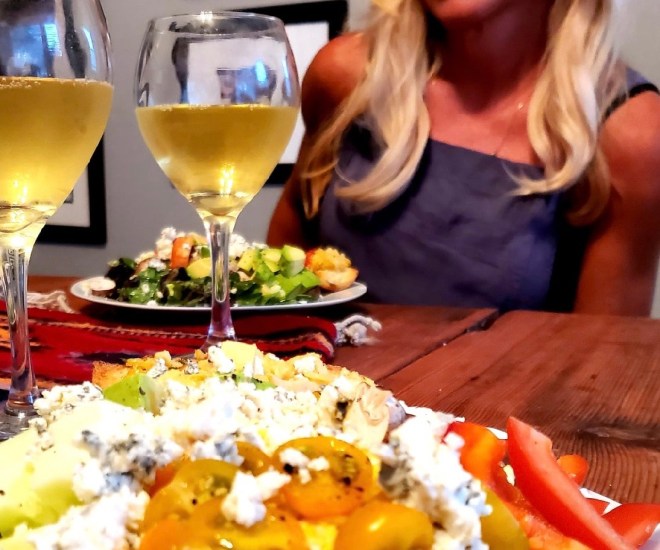Tuna. It’s a staple in a lot of peoples diets. Heck, even those that “think” they don’t like seafood, will eat tuna. BTW my husband has perfected searing tuna … yes, inside the house, and no, it doesn’t make everything smell like fish. But, before you checkout his “technique,” take a few minutes and familiarize yourself with the different types of tuna on the market.
October is National Seafood Month (and I’m a big fan) so I’ll be reposting some old favorites along with some new ones as well … hope to see you here throughout the month : )
Here in the U.S., canned tuna is the number two consumed seafood, preceded by shrimp and followed by salmon.
And though it’s true, not as much fresh tuna is eaten as canned, it’s still one of the preferred choices among restaurant goers. But. While a rose is a rose is a rose might be true, a tuna is a tuna is a tuna, couldn’t be further from the truth.
Albacore tuna has a higher omega-3 content than its smaller cousins making it a heart-healthy choice—but it also has around three times as much mercury (as most larger fish have a higher level of mercury than smaller fish) which is why young children and pregnant women need to be cautious. Legally, here in the U.S., albacore is the only species that can be labeled “white” tuna. Found mostly in the warm Pacific waters, its thick, “meat-like” texture makes it a great option for those who tend to prefer steak over seafood.
Yellowfin tuna, also known as ahi, run in the warm waters of the Pacific and the Atlantic and are smaller than albacore. The bright red flesh turns an ashy-gray when cooked but this species is often served partially raw—just seared briefly—and as sashimi in Asian cuisine.
Ahi is the Hawaiian name for yellowfin tuna
Skipjack tuna is the most commonly used species for canning. And, although it’s rare to find it in a retail environment, if you do, don’t shy away. The flavor and texture is similar to yellowfin when cooked and can be excellent when grilled. Note, I recommend cooking through and through rather than searing.
Canned chunk light tuna is skipjack
Bluefin tuna is a delicacy. But I won’t eat it and I stand with the hundreds of purveyors and like-minded chefs who refuse to offer the fish in their restaurants: “
The culinary community has a key interest in the recovery of all bluefin tunas, and particularly Pacific bluefin tuna,” the chefs stated. “Preserving healthy populations of bluefin tunas in the ocean is a prerequisite to bringing these delicious fish back to the menu.”
Most bluefin tuna are on the Seafood Watch avoid list: “The stocks are depleted, and overfishing is still occurring. The catch of turtles, seabirds, marine mammals, sharks and other vulnerable species is also a critical concern. In addition, the management measures to help bluefin stocks recover and reduce the catch of endangered, threatened or overfished species are rated highly ineffective.” Read the entire Atlantic Ocean Bluefin Tuna Seafood Watch Report.
However, the National Oceanic Atmospheric Administration’s Fish Watch has this to say about bluefin tuna:
- Although Pacific-wide populations are well below target levels, U.S. wild-caught Pacific bluefin tuna is a smart seafood choice because it is sustainably managed under rebuilding measures that limit harvest by U.S. fishermen.
- Based on the information in the 2017 stock assessment, NOAA Fisheries has determined that the western Atlantic bluefin tuna stock has an unknown overfished status. Read more from FishWatch.gov on bluefin tuna.
Roughly 97 percent of Pacific bluefin tuna have vanished ~ International Commission for the Conservation of Atlantic Tunas
But the bluefin debate isn’t isolated to the American market—far from it. In an article earlier this year, The Japan Times, reported on lagging policy and lack of sustainable practices that have led to overfishing of bluefin tuna and other species: “When I found out about the situation in Japan, I felt like it was time for people to know more about the issue,” says Chefs for the Blue core member Fumio Yonezawa of Michelin-starred Jean-Georges Tokyo. “I have two kids, and I would love to share our beautiful seafood with future generations.” Yonezawa, along with some of Tokyo’s top chefs, scientists, and others have founded Chefs for the Blue to help raise awareness and bring positive change to the industry.
Bottom line … until there’s a significant increase in the population of bluefin, and a dramatic and measurable shift in fishing management of the species, don’t eat bluefin tuna. And don’t support restaurants that offer it. Wait. It will rebound. It will be available again, and when it is, you can enjoy the delicacy that it is in good conscience. PHOTO SKETCHES courtesy NOAA, FishWatch.gov.
Live consciously, love fiercely, and eat well.
-Shauna Gabriel



Such an informative blog. Loved it. I am a travel blogger from India. Please give my blog a read too.
LikeLike
Good article Shauna!
Many of the cans are well marked these days.
LikeLike